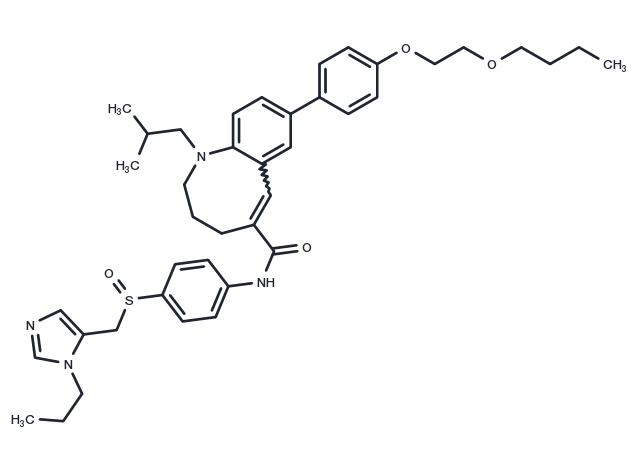Powder: -20°C for 3 years | In solvent: -80°C for 1 year
Cenicriviroc (TAK-652) 是一种可口服的CCR2/CCR5拮抗剂,可抑制 HIV-1 和 HIV-2,具有抗炎、抗感染作用。

| 规格 | 价格/CNY | 货期 | 数量 | |
|---|---|---|---|---|
| 1 mg | ¥ 851 | 现货 | ||
| 2 mg | ¥ 1,280 | 现货 | ||
| 5 mg | ¥ 2,450 | 现货 | ||
| 10 mg | ¥ 3,930 | 现货 | ||
| 25 mg | ¥ 5,780 | 现货 | ||
| 50 mg | ¥ 7,990 | 现货 | ||
| 100 mg | ¥ 10,800 | 现货 | ||
| 200 mg | ¥ 14,600 | 现货 | ||
| 1 mL * 10 mM (in DMSO) | ¥ 2,230 | 现货 | ||
| 产品描述 | Cenicriviroc (TAK-652) is an orally active, dual antagonist of CCR2/CCR5. It also inhibits both HIV-1 and HIV-2, and displays potent anti-infective and anti-inflammatory activity. |
| 靶点活性 | CCR5:0.29 nM, CCR2:5.9 nM, R5 HIV-1:0.024-0.08 nM (in PBMCs), R5 HIV-2:0.03-0.98 nM (in PBMCs) |
| 体外活性 | Cenicriviroc 阻止 HIV-1 的细胞进入[2]。就测试的 4 个 R5 HIV-2 临床分离株而言,cenicriviroc 的有效浓度 50% (EC50) 分别为 0.03、0.33、0.45 和 0.98 nM。具有双重亲和性和 X4-亲和性的 HIV-2 株对 cenicriviroc 显示出抗性,其 EC50 值均 >1000 nM,MPI 分别为 33% 和 4% [3]。 |
| 体内活性 | Cenicriviroc (≥20 mg/kg/天) 在体内显著减少单核细胞/巨噬细胞的招募。在NASH模型中,cenicriviroc 显著降低非酒精性脂肪肝病活动评分。Cenicriviroc治疗对体重或肝/肾重量没有显著影响[1]。 |
| 动物实验 | Male C57BL/6 mice (n=44; 8-10 weeks of age) are allocated to receive treatments via oral gavage (PO) on Days 1-5 in the following groups: non-disease control, vehicle control twice daily (BID), Cenicriviroc 5 mg/kg/day (Cenicriviroc5) BID, Cenicriviroc 20 mg/kg/day (Cenicriviroc20) BID, Cenicriviroc 100 mg/kg/day (Cenicriviroc100) BID, Cenicriviroc20 QD, and positive control (corticosteroid known to reduce inflammation in a variety of animal models) 1 mg/kg QD. On Day 4, peritonitis is induced via IP injection of TG 3.85% (1 mL/animal) 2 hours post-dose in all groups except non-disease controls [1]. |
| 别名 | TAK-652, TBR-652 |
| 分子量 | 696.94 |
| 分子式 | C41H52N4O4S |
| CAS No. | 497223-25-3 |
Powder: -20°C for 3 years | In solvent: -80°C for 1 year
DMSO: 120 mg/mL (172.19 mM)
| 可选溶剂 | 浓度 体积 质量 | 1 mg | 5 mg | 10 mg | 25 mg |
| DMSO | 1 mM | 1.4348 mL | 7.1742 mL | 14.3484 mL | 35.8711 mL |
| 5 mM | 0.287 mL | 1.4348 mL | 2.8697 mL | 7.1742 mL | |
| 10 mM | 0.1435 mL | 0.7174 mL | 1.4348 mL | 3.5871 mL | |
| 20 mM | 0.0717 mL | 0.3587 mL | 0.7174 mL | 1.7936 mL | |
| 50 mM | 0.0287 mL | 0.1435 mL | 0.287 mL | 0.7174 mL | |
| 100 mM | 0.0143 mL | 0.0717 mL | 0.1435 mL | 0.3587 mL |
对于不同动物的给药剂量换算,您也可以参考 更多...
请在以下方框中输入您的动物实验信息后点击计算,可以得到母液配置方法和体内配方的制备方法: 比如您的给药剂量是10 mg/kg,每只动物体重20 g,给药体积100 μL,一共给药动物10 只,您使用的配方为5% DMSO+30% PEG300+5% Tween 80+60% ddH2O。那么您的工作液浓度为2 mg/mL。
母液配置方法:2 mg 药物溶于 50 μL DMSO (母液浓度为 40 mg/mL), 如您需要配置的浓度超过该产品的溶解度,请先与我们联系。
体内配方的制备方法:取 50 μL DMSO 主液,加入 300 μL PEG300, 混匀澄清,再加 50 μL Tween 80,混匀澄清,再加 600 μL ddH2O, 混匀澄清。
您可能有的问题的答案可以在抑制剂处理说明中找到,包括如何准备库存溶液,如何存储产品,以及基于细胞的分析和动物实验需要特别注意的问题。
Cenicriviroc 497223-25-3 Immunology/Inflammation Microbiology/Virology Proteases/Proteasome HIV Protease CCR CC chemokine receptor TAK-652 inhibit HIV TAK652 Inhibitor Human immunodeficiency virus TAK 652 TBR652 TBR-652 TBR 652 inhibitor
